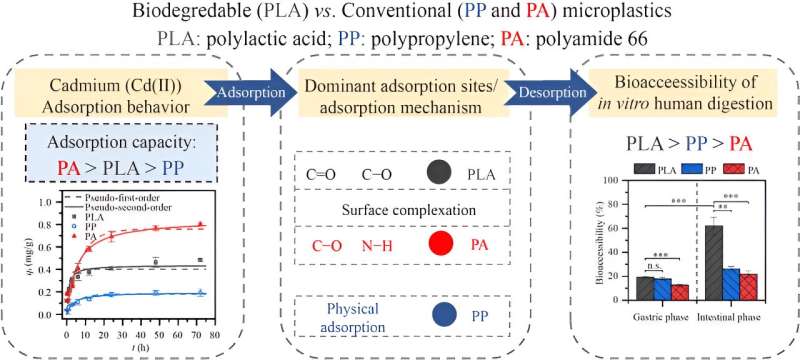This article has been reviewed according to Science X's editorial process and policies. Editors have highlighted the following attributes while ensuring the content's credibility:
fact-checked
trusted source
proofread
Hidden dangers in eco-friendly choices: The health risks of biodegradable microplastics revealed

A study published in Frontiers of Environmental Science & Engineering on September 25, 2023, unveils the potential health risks associated with biodegradable microplastics, particularly polylactic acid (PLA).
This in-depth study offers a nuanced exploration of the interactions between biodegradable microplastics, specifically polylactic acid (PLA), and the heavy metal cadmium (Cd(II)). It meticulously examines and contrasts the adsorption and desorption processes of these microplastics in varied environments, ranging from natural ecological settings to simulated human gastrointestinal conditions.
This comparative analysis extends to traditional non-biodegradable microplastics, providing a rich understanding of the different environmental behaviors of these materials. Significantly, the research unveils that, despite the biodegradability of PLA, its interaction with cadmium can lead to substantial health risks.
These findings are instrumental in deepening our comprehension of the multifaceted environmental impact of microplastics, especially in relation to human health and safety, thus enriching the discourse on the ecological implications of both conventional and biodegradable plastics.
Researchers Dr. Xiang Wu and Dr. Shushan Yuan, emphasize the importance of understanding the complex behavior of biodegradable microplastics and their potential impact on human health.
This research highlights a critical gap in our understanding of microplastics' environmental impact. It suggests that biodegradable microplastics might not be as harmless as previously thought, especially when contaminated with toxic substances.
Highlights
- The Cd(II) adsorption capacity followed the order of PA > PLA > PP.
- Oxygen groups played critical roles in Cd(II) adsorption by PLA MPs.
- Degradation of PLA MPs enhanced Cd(II) desorption in human digestive fluid.
- Cd(II) release was easier from PLA during human digestion than from PP or PA.
The study sets a foundation for future research into the long-term impacts of biodegradable microplastics on human health and the environment. It emphasizes the need for more thorough regulations and guidelines to effectively manage the use and disposal of these materials.
More information: Timing Jiang et al, A potential threat from biodegradable microplastics: mechanism of cadmium adsorption and desorption in the simulated gastrointestinal environment, Frontiers of Environmental Science & Engineering (2023). DOI: 10.1007/s11783-024-1779-4
Provided by Chinese Academy of Sciences





















